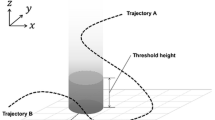Abstract.
Two methods of back trajectories have been applied for 14 precipitation events. One method consisted of a combination of isentropic and constant level trajectories. The second method consisted only of the constant level trajectory. For each method a long range and a local contribution to the chemistry of the precipitation was calculated. The long range contribution was calculated by taking into account the SO2 an NOx emissions in the areas of the mixed layers traversed by the trajectories, the diffusion, and the dry and wet depositions along the trajectories path. For the local contribution, local emissions and the dry deposition were taken into account. From these contributions expected values of sulfate and nitrate in the precipitation were calculated and these values compared with the observed ones. Results indicate that: a) the isentropic-constant level model is much better in estimating the measured concentrations of sulfate and nitrate in precipitation than the constant level mode, and b) the long range transport of precursors contributed more to the total concentration than the local emissions.
Similar content being viewed by others
References
Carlson, T.N.: 1980, Monthly Weather Review, 108, 1499.
Danielsen, E.F. and Bleck, R: 1967, Moist Isentropic Flow and Trajectories in a Developing Wave Cyclone, USAF Tech. Rept. No. 67-0617, Air Force Cambridge Res. Lab., 1-34 [NITS AD 670-847].
Danielsen, E.F.: 1961, Journal of Meteorology, 18, 479.
Draxler, R.R.: 1979, Atmospheric Environment, 13, 1559.
Hefter, J.L.: 1980, Air Resources Laboratories Atmospheric Transport and Dispersion Model, NOAA Technical Memorandum ERL ARL-81, U.S. Dept. of Commerce, 17 pp.
Hefter, J.L, Taylor, A.D.: 1975, A Regional-Continental Scale Transport, Diffusion, and Deposition Model, Part 1: Trajectory Model, NOAA Technical Memorandum ERL-50, U.S. Dept. of Commerce, 16 pp.
Holian, J.O.: 1984, Acid Precipitation: Applying Isentropic Trajectories to Determine Source-Receptor Relationships. M.S. Thesis, Dept. of Meteorology, The Pennsylvania State University, University Park, PA 16802, 67 pp.
McMahon, T.A. and Dennison, P.J., 1979, Atmospheric Environment, 13, 571.
Pena, R.G. de, Carlson, T.M., Takacs, J.F. and Holian, J.O.: 1984, Atmospheric Environment, 18, 2665.
Wisniewski, J. and Sax, R.I.: 1979, Journal of Applied Meteor., 10, 1044.
Author information
Authors and Affiliations
Additional information
Author for all correspondence.
Rights and permissions
About this article
Cite this article
de Pena, R.G., Rolph, G.D., Takacs, J.F. et al. Application of trajectory analysis to the assessment of local and long-range contributions to acidic deposition. Water Air Soil Pollut 30, 885–896 (1986). https://doi.org/10.1007/BF00303355
Issue Date:
DOI: https://doi.org/10.1007/BF00303355




